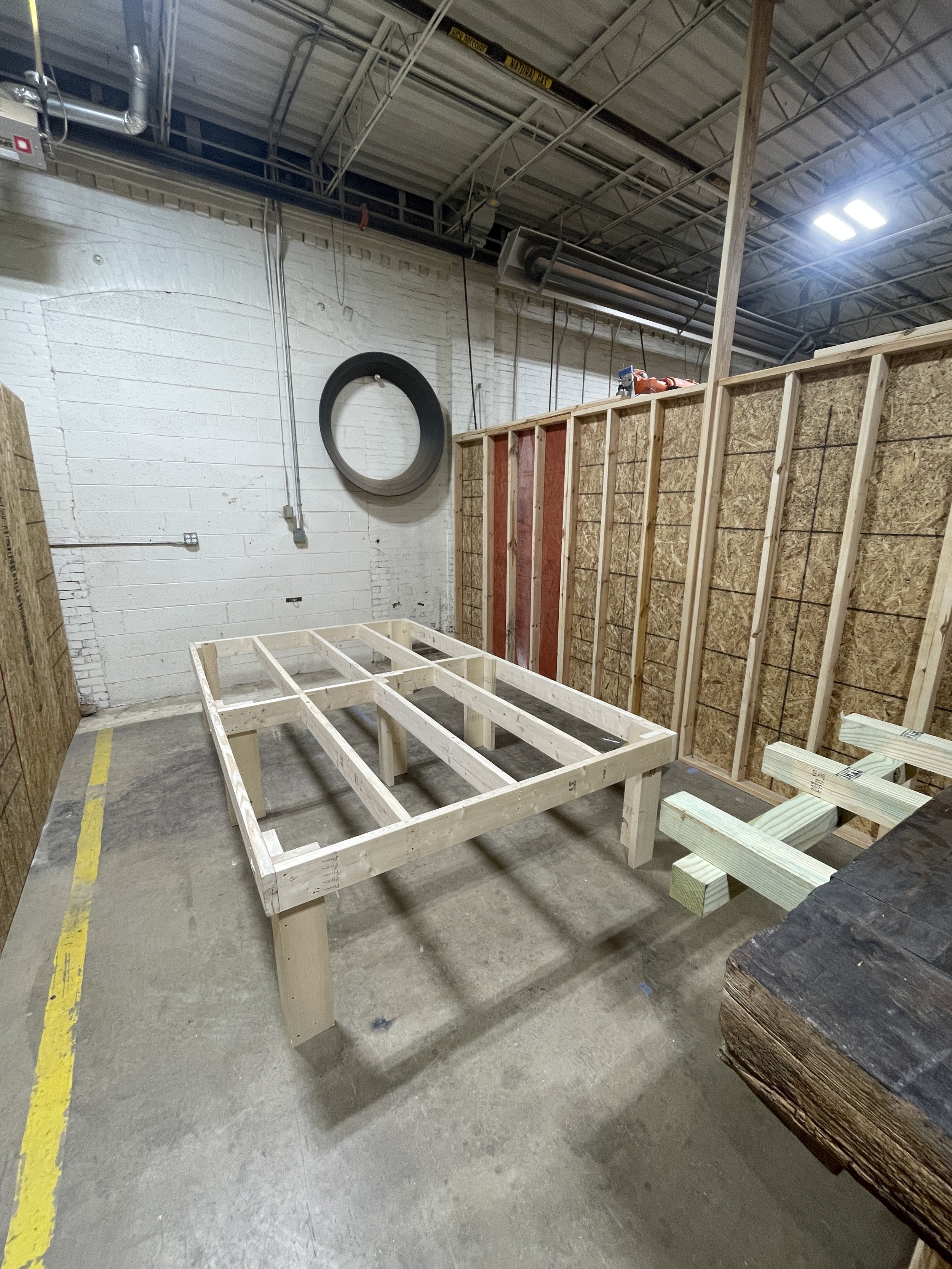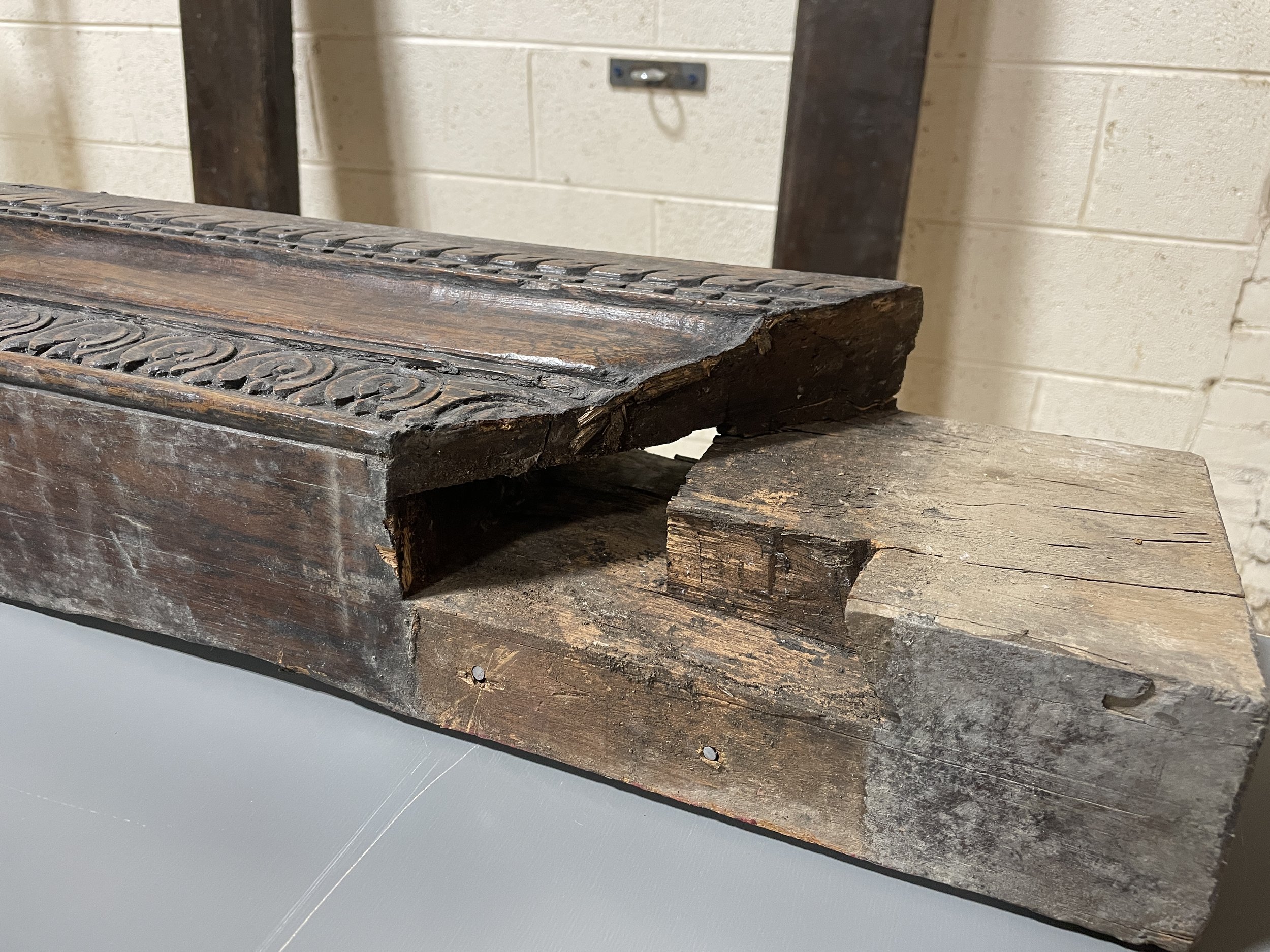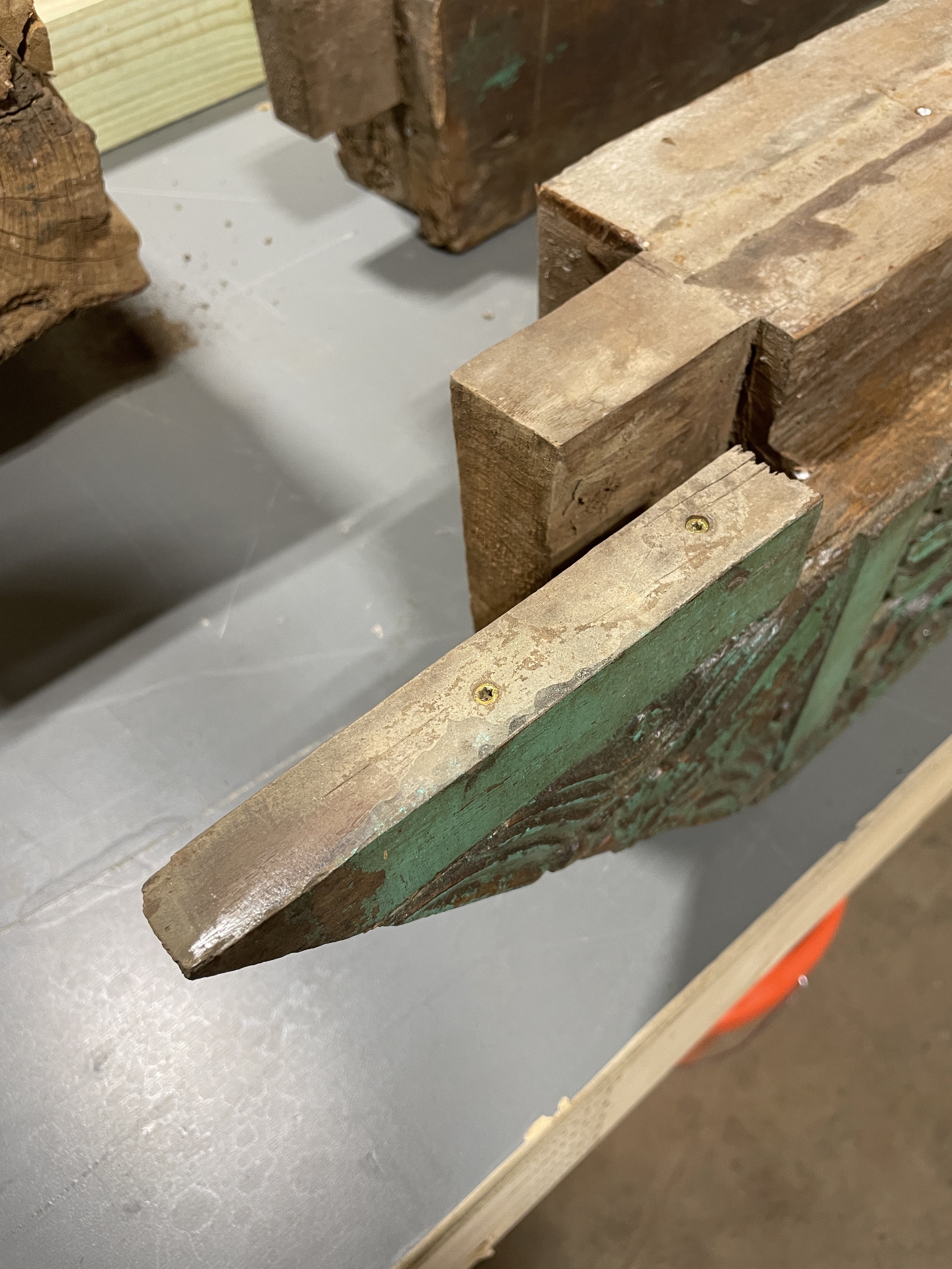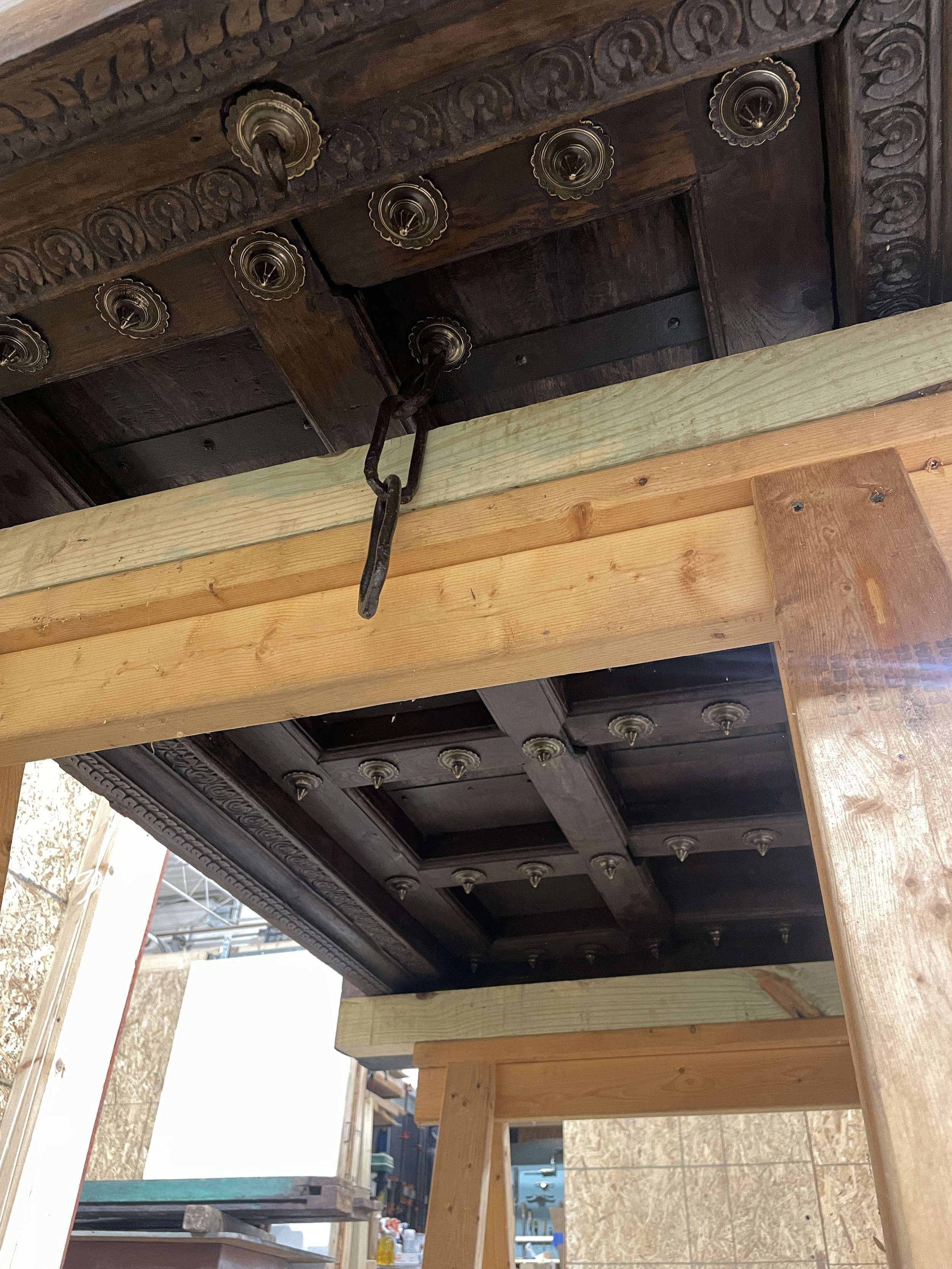HAVELI DOORS
Before:
3/4 — 3/7
Week of 3/3/25 focused on workspace setup and cleaning tests for Elephant and Black doors. Met with Josh to confirm project scope; awaiting update on work table. Built and installed work table by midweek.
Elephant door grime responded to denatured alcohol, likely indicating shellac; requires repeated applications. Abrasive methods damaged paint. Water ineffective. Black door tests included Dawn, Murphy’s, CLR, vinegar, Danish oil, and Citrasolv. Wood is highly absorbent, suggesting no protective finish. Diluted Murphy’s gave best result—cleaned mildew without discoloring wood. Citrasolv and Danish oil helped mask staining; long-term effectiveness uncertain.
Friday, fully cleaned show face of one Black door using soap, diluted CLR, and Citrasolv. Skipped vinegar due to potential iron reaction. Surface now clean; monitoring for mold or stain recurrence. Supplies sourced from Home Depot and Woodcraft, including shellac, denatured alcohol, and lightbulbs.
3/10 — 3/13
Week of 3/10/25 focused on disassembling, cleaning, and structurally stabilizing the Black door. Began by dismantling the door and cutting through nails driven into joints. Remaining nails will need removal or trimming. Initial assessment led to the decision to avoid relying on original joinery. Instead, hidden auxiliary hardware (e.g., threaded inserts, bolts, angle iron) will be used to allow for knock-down reassembly, easing future transport, installation, and repair. Surface repairs, including filling damaged wood and nail holes, will also be necessary.
Cleaning continued throughout the week. Denatured alcohol and soap were used initially, with diluted CLR applied later for mold removal. Discovered that the door is stained and partially finished; exposed areas without a finish are water-soluble and vulnerable to cleaning.
Repairs included gluing and screwing cracked parts, though glue failed on some oily woods—possibly teak—requiring rework with epoxy and GRK trim screws. Wax used to conceal screw holes. Eric Olgren advised against kiln-drying for mold mitigation, suggesting a DIY heated chamber instead. Additional repairs were made with epoxy and wood flour, including rebuilding a damaged miter on the applied trim. Supplies sourced from Home Depot and specialty retailers.
3/17 — 3/20
Week of 3/17/25 involved continued cleaning and testing on both the Black and Elephant doors. On 3/17, all Black door parts were wiped down with Citrasolv, bringing them to a uniform baseline. Further tests included Danish oil and a thin wash coat of blond shellac; both are likely needed to restore surface richness and provide reversible sealing. Consideration given to thinning Tried & True Danish oil with solvent for better application. A dry rot test with wood hardener yielded inconclusive benefits.
Black door parts were moved to Josh’s studio and the Elephant door brought into the main workspace. Alcohol tests on the Elephant door were partially effective but inconsistent, especially on thicker grime. This suggests a possible varnish layer. Research indicated distilled turpentine might help; additional solvent tests were planned.
Turpentine and artist-grade mineral spirits were tested with no success. Acetone removed grime but also lifted paint. Alcohol continued to perform moderately well. Cleaning proceeded with an alcohol soak-wipe method. A meeting with Josh covered cleaning strategy, finish options, and hotboxing. Decorative hardware was removed from the Green door for scanning; cavity was heavily soiled, suggesting full hardware removal before cleaning.
3/24 — 3/26
Week of 3/24/25 included continued cleaning of the Elephant door and initial work on the Green door. Alcohol cleaning was extended to the back of one Elephant door. A meeting with Josh covered plans for cleaning, finishing, hotboxing, and mounting. Additional alcohol was sourced, and further tests with distilled turpentine on pre-cleaned areas yielded mixed results. Efforts to remove the remaining brown grime are ongoing. Decorative hardware was removed from the Green door for scanning. The cavity beneath was heavily soiled, suggesting that all hardware should be removed prior to wood cleaning and preservation.
4/8 — 4/11
Week of 4/8/25 focused on disassembly and initial cleaning of the Green door. The door was fully taken apart on 4/8; nails and screws were cut to minimize damage, though some remedial work will be needed. A small split during disassembly was repaired with epoxy and trim screws. Plans were made to assess and clean hardware, including addressing potential rust and evaluating the metal screen for the transom window.
Cleaning began with diluted Dawn. The main door components were fully cleaned by 4/10. Attention turned to the transom window, with decisions pending on whether to replace or retain the existing glass.
By 4/11, the transom was cleaned and solvent tests were conducted on the Green door’s paint, yielding no major results. Next steps include testing a clear or seal coat—likely shellac or polymerized linseed oil. Work also began on preparing a table for the hotbox setup.
4/14 — 4/17
Week of 4/14/25 centered on finalizing the hotbox setup and advancing work on the Green door. Components for the hotbox and heater stand were cut and assembled, with a propane refill pending. Hardware on the Green doors was cleaned with a wire wheel, and further solvent tests on the paint coating were inconclusive—removal without damaging underlying color proved unviable. Citrasolv offered minimal cleaning gains. Tests with shellac showed potential for enhancing color and gloss.
Wood repairs were made on a Green door post, and the warped tenon on the top beam was pared down to allow easier reassembly. Buffing wheels were purchased to polish brass hardware on the Black door.
By 4/16, joinery adjustments ensured smooth reassembly of the Green door. A hotbox test confirmed safe operation and effectiveness, with all parts reaching ~160°F, though heat was uneven. On 4/17, all parts from both doors were successfully processed in batches to maintain consistent temperatures.
4/21 — 4/24
Week of 4/21 focused on polishing hardware, documentation, and beginning finish treatment. Remaining Elephant door parts were cooked on 4/21. Brass hardware on the Black doors was fully polished by 4/23. Restoration photos were organized and uploaded to a private client webpage.
On 4/24, Tried & True Danish Oil (polymerized linseed oil) was applied to all Black door parts, including hardware, to restore surface saturation and provide moisture resistance. Application involved flooding surfaces with a chip brush, distributing with a rotary brush, brief penetration time, and wiping with microfiber cloths. Inconsistent surfaces may lead to uneven sheen; if needed, a final coat of shellac and/or beeswax-mineral oil wax may follow. The finish approach is conservation-minded—meant to preserve the doors’ aged, worn character rather than make them look new.
4/29 — 5/1
Week of 4/29: Met with Josh to review progress and next steps. Applied polymerized linseed oil to all remaining Black and Green door parts. Treated dry-rotted threshold on Black door with wood hardener.
5/5 — 5/9
Week of 5/5: Continued testing finishes to determine appropriate sheen—leaning toward matte or dull satin to avoid visual interference from gloss. Goal is to unify surface appearance without detracting from the doors' complex forms. A final topcoat will help even out current uneven sheen from surface wear. Planning to test Kleaevar spray finish. Began fitting and re-fastening Black door frame using large washer-head lag screws.
5/13 — 5/16
Week of 5/13: Finished assembling Black door frame with structural lag screws. Identified front-side warping in one door preventing full closure. Resolved by securing both doors together using unistrut with threaded inserts and hex bolts. Mounted unistrut on 5/15 to flatten and stabilize. On 5/16, attached cornice and bobbin molding to the frame using screws and threaded inserts.
5/20 — 5/23
Week of 5/20: Reassembled Black door trim frame using countersunk structural lag screws; repaired a broken stile with epoxy. Planed down the edge of the two-door unit to ensure smooth fit into the frame, then matched the exposed wood with custom shellac stain. Began reassembly of the Elephant door frame, dry-fitting parts and planning joinery. Identified the wood as likely sandalwood—extremely dense—making boring slow and difficult. Auger bits repeatedly jammed due to compacted waste; required clearing holes every inch. Despite caution, ruined two bits during the process.
5/27 — 5/29
Week of 5/27: Finished boring and countersinking remaining holes in the Elephant door frame using a new auger bit, without further issues. Attached unistrut to the back of the Elephant doors to align and unify their front appearance. Installed a temporary threshold on the frame and determined final door placement within it. Repaired a damaged frame tenon using large structural screws.
6/4 — 6/6
Week of 6/3: Began reassembling the Green door frame, laying out and boring holes for structural lag screws. Once assembled, the frame was flipped and doors placed within it. Repaired broken wood in the header with epoxy. Updated both the work log and photo documentation, including additions to the project’s web page. Finished the week by cutting and attaching unistrut to the Green doors to align and stabilize them.



























































































































































































































































































